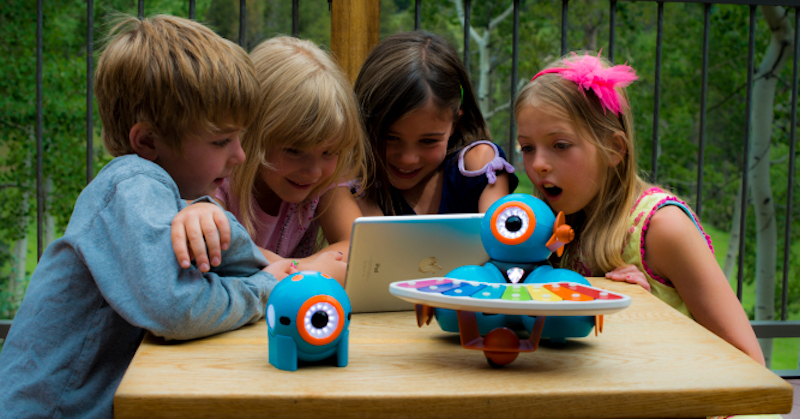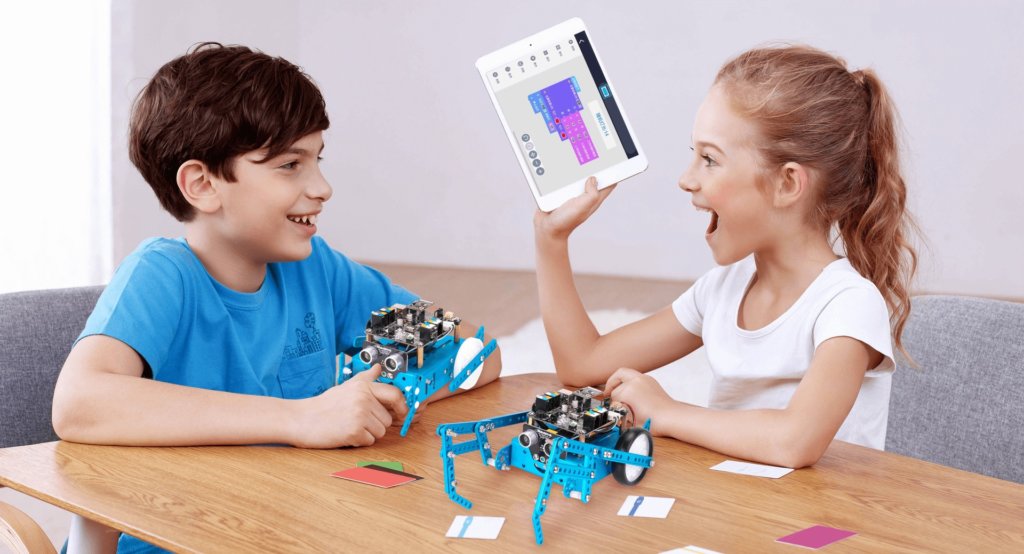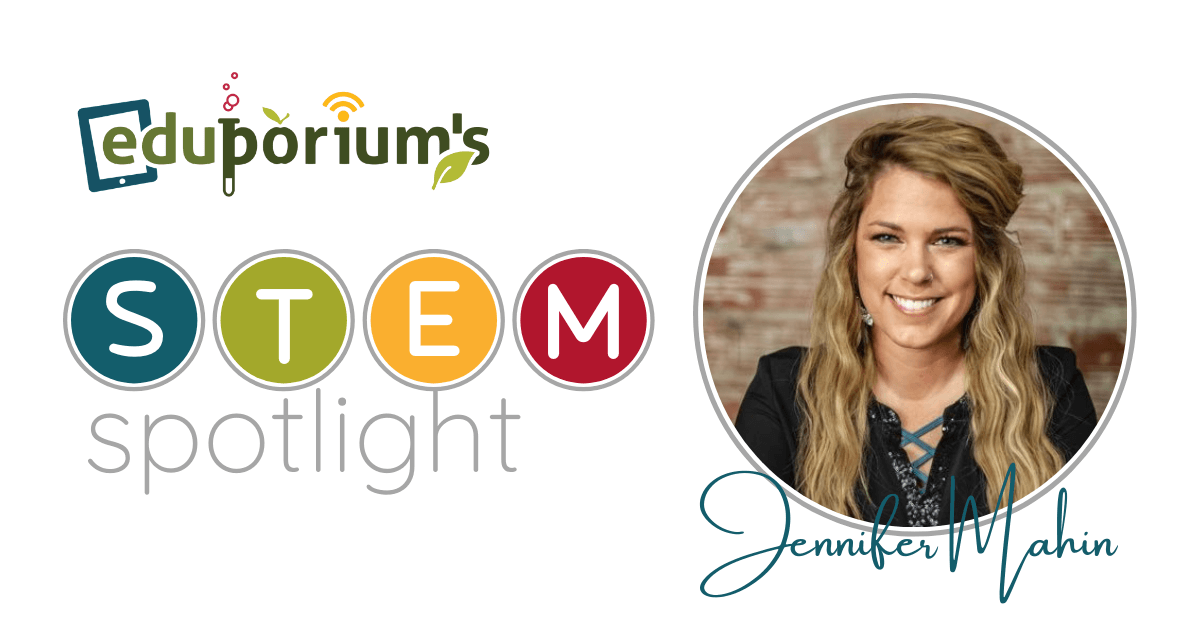Today, we're excited to introduce a new recurring blog series to our STEM content selection! Over the past few months, we've been working with various STEM and education professionals to help tell their STEM stories. We know it takes a lot of commitment and an eye for innovation to create meaningful learning opportunities for both students and educators and we're really excited to share some of these stories with our audience while, hopefully, introducing them to some new STEM personas to follow and learn from. To kick things off, our first question-and-answer feature is with Jennifer Mahin, a K-5 STEM and technology teacher in Belleville, Kansas!
1. What inspired you to get into the STEM education field?
When I started my journey in STEM it was actually unintentional. I had just graduated with my Master of Science in instructional technology and wanted to be a technology integration specialist. At the time, our school was looking to transition our previous keyboarding class to a STEM class. To accommodate me, they grouped STEM and tech integration together. At the time, I was a fifth-grade math and social studies teacher and already integrating STEM into my social studies and basic coding into my math lessons. In my eyes, I was doing this to make the subjects I was teaching more innovative, engaging, and hands-on. I didn’t want to just teach a lesson. I wanted to create a learning experience and STEM helped me do that. But, I honestly never pictured myself actually being a STEM teacher.
2. If you were designing the ideal STEM space, what are the three must-have items that you would need to include?
Three things I always wish I had more of would be storage space, open space for students to use their robotics kits, and charging stations. I feel like space is my biggest struggle! Whether I’m trying to store projects from one class to the next or find space to store the various robots, building materials, and donations, there’s never enough room. I'm lucky to have all my chairs and tables on wheels, however, so I often wheel them into the hallway to make more space for robotics activities. I also feel like there are never enough outlets or a perfect way to charge iPads, Chromebooks, or robots, so I’m always left with a ball of charging chords.
If we’re talking about STEM in general, however, my must-have items would definitely include Ozobots since they're so great to use with all K-5 students. Second would be Flipgrid because it’s such a fun tool for empowering students, creating collaboration across grade levels, maintaining portfolios of projects, documenting the design process, and helping students present the final project. My third choice would be LEGOs. LEGOs are so versatile and can be used in so any different ways when it comes to STEM.

3. How do you see the skills students learn from STEM and EdTech experiences applied in other subject areas?
I think it's so easy to make cross-curricular connections with STEM and EdTech. STEM doesn’t have to be just science, technology, engineering and math. As a fifth grade teacher, I used STEM most often in social studies projects. It was an opportunity for students to show me in a hands-on way what they'd learned. They could group so many different aspects of a chapter into one assignment. With STEM, students are learning problem-solving, communication, resilience, creativity, and experimentation skills all in one. Another key component to STEM that students are learning is failure and that things won’t always work as planned.
In STEM experiences, your project might not always work the first time and that’s okay. With the right STEM mindset, however, students realize the value in being able to stop, re-evaluate, and make changes in order to accomplish their goals. In school, students are taught that failure is not okay but, in actuality, there are tons of times they might not get things right on the first try. By teaching students the design process, resilience, and problem solving, we’re creating a community of thinkers who know how to fix things when they don’t go as planned from the beginning. All of these skills are things students need in every subject area and in many aspects of life outside of school.
4. Based on your knowledge/experience, what are some of the most in-demand skills today’s students should be developing?
When I think of in-demand skills, I think of skills that will prepare students for their future outside of the classroom. Computer science skills are high on that list for me since 71 percent of all US jobs require digital skills. Computer skills, in general, should be something educators focus on helping students develop from a young age. Another valued skill would be communication. Being able to effectively work with people is definitely a top skill for many careers. I also believe students should learn how to be problem solvers and think quickly on their feet.
5. Do you think—on average—they have access to learning that effectively helps them build these skills?
I do not think students in every school are being prepared with these skill sets early on. I am located in a rural district in Kansas. We are part of a few schools within two hours in which STEM is taught to every single student in kindergarten through fifth grade. It seems that, in most schools, STEM is seen as something that's solely for gifted students or incorporated in instruction on an occasional basis and for a shot period of time. The other trend I see is STEM not being taught at all until middle or high school.
Our students, however, are learning these skills from a young age every single week and getting the opportunity to use them in the STEM lab and our makerspace, which is accessible to every educator throughout the day. I think education leaders can do more to make sure all students are developing these skills from a young age and not just once they're hitting middle school or high school.

6. Do you have any thoughts on how STEM tools could help kids build a strong SEL foundation?
SEL is so important to incorporate into any and every subject area. Once students know they are safe and welcome, their engagement rates go up and their work ethics naturally improve. I think STEM and social-emotional learning go hand-in-hand due to the skill sets students can build in any given STEM classroom. STEM challenges, coding, and robotics are laying a foundation for them to learn problem-solving skills and collaboration and educators can easily adapt these activities for students of all ability levels.
Throughout STEM experiences, students are working with a team to become creative problem solvers. It’s so important for educators to create a community in which each member builds the others up. In my eyes, STEM learning is the way to do that. For example, when a STEM challenge fails, instead of laughing at another group, students should help them. They should actively look for how they can help all groups be successful. Setting your students up for achieving success beyond their own is key.
Besides building relationships with students, it's important for teachers to make sure students know you see them and want to understand their culture or life a little better. Students want to feel included and loved. I love to incorporate literature and children’s books into my STEM challenges. One thing I've done in my classroom is to make sure that all students feel included and can see themselves in the characters. Being in rural Kansas, there isn’t a lot of diversity in our district, but I still want to make sure every student feels included. I want my students to know that we have a place for them here in our community and in STEM.
I made sure to start purchasing picture books with students of many races and cultures so that, as I was reading a story, my students—no matter their gender or race—could identify with the character and feel like there was a place for them in the STEM community. When it comes to holiday STEM challenges, if I have students celebrating different holidays and cultures, we'll include all of them in our projects. This year, I added the Chinese Lunar New Year and robotics activities on women in science and Black History Month. Creating trust and building relationships through SEL should be incorporated into every subject area and STEM is no different.
7. What are some of the strategies you know to be successful in helping students develop Future-ready skills?
Future-ready learning is all about developing lifelong skills that students can apply in multiple ways as they mature. I love focusing on trying to create global learners who strive to make an impact with real-world innovation. I think the best way to accomplish this is with student-led learning. Let students take charge of their learning. Help students tailor their learning in a way that helps them. Give students the opportunity to be creative, adaptive, and to think outside the box. STEM education leads to students developing all of these skills and practicing them from a young age. In my classroom, I like to let students take charge of their learning path and believe this is how educators can help create global learners.
8. Based on any industry knowledge, what are some trends you see becoming prominent in STEM education over the next couple years?
I see STEM being more accessible and readily available for students in every single grade level. I feel like I am working to pave the way for STEM education and CS in rural Kansas. I’ve attended many conferences and trainings that focus on STEM in middle and high school, but I feel that STEM in early education is going to take off in short order. I also think with more educators going down this path there will be more research, materials, and resources available to educators who want to commit to starting a makerspace or school STEM program.
When I started my STEM classroom two years ago, it was hard to know what resources to purchase or where to start. I ran into the same issues this past year as I was starting my makerspace classroom. I think the push for STEM and CS learning is going to be held to a higher value in schools in the very near future.
We thank Jennifer so much for taking the time to share her insights with our STEM community. It was certainly great having her share her thoughts to kick off this new series! If you know of anyone who deserves to be highlighted in a similar way for contributions to STEM education inside or outside the classroom, please get in touch with us. For more STEM content and helpful educator resources, follow us on Twitter and Instagram!



